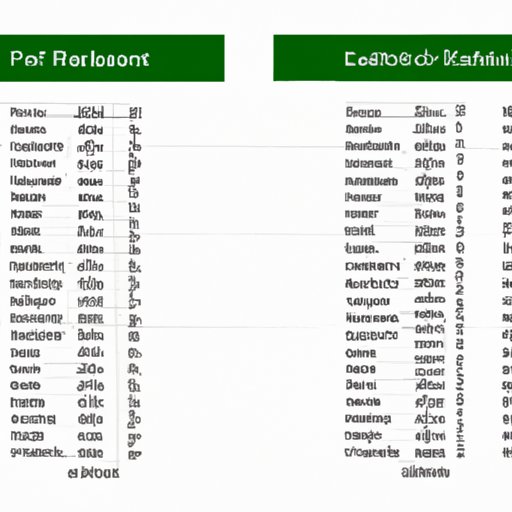I. Introduction
Excel is a powerful and widely used software tool that can be used for various purposes. However, when you are working with data, you might come across the issue of duplicate values. Duplicate values can create confusion, and can lead to errors in your results while analyzing data. This is why it’s important to know how to identify and remove them from Excel spreadsheets. In this article, we will discuss different ways to highlight duplicates in Excel.
II. Basic Method
The built-in “Conditional Formatting” option in Excel can be used to highlight duplicate values quickly and easily. Here’s how:
- Select the range of cells where you want to highlight the duplicates
- Go to the “Home” tab and click on “Conditional Formatting” under the “Styles” group
- Choose “Highlight Cells Rules” and then “Duplicate Values”
- Select the formatting style that you want to apply to the duplicates
- Click “OK”
Now, all the duplicates in the selected range will be highlighted.
Here’s an example in a table below:

III. Advanced Method
Excel’s conditional formatting can be used to highlight duplicates based on the unique values in a defined range. This method is slightly more advanced, but once you get the hang of it, it’s a powerful tool to have in your Excel toolbox. Here’s how:
- Select the range of cells where you want to highlight duplicates
- Go to the “Home” tab and click on “Conditional Formatting”
- Choose “New Rule” and then “Use a formula to determine which cells to format”
- Enter the formula
=COUNTIF($A$1:$A$10,A1)>1where$A$1:$A$10is the range you want to check for duplicates andA1is the active cell in the selected range - Select the formatting style that you want to apply to the duplicates
- Click “OK”
Now, all the duplicates based on unique values in the defined range will be highlighted. Here’s an example:

IV. Highlighting Duplicate Values Across Multiple Sheets
If you have data that is in multiple sheets and you want to see if there are any duplicate values across these sheets, you can use Excel’s conditional formatting feature. Here’s how:
- Select the range of cells where you want to highlight duplicates
- Go to “Conditional Formatting” and choose “New Rule”
- Choose “Use a formula to determine which cells to format”
- Enter the formula
=COUNTIF(Sheet2!$A$1:$A$10,A1)>0, whereSheet2!$A$1:$A$10is the range of cells to be searched andA1is the active cell in the selected range - Select the formatting style that you want to apply to the duplicates
- Click “OK”
All the duplicate values will now be highlighted across the selected sheets. Here’s an example:

V. Remove Duplicate Values
If you want to remove the duplicate values in Excel instead of just highlighting them, follow these steps:
- Select the range of cells where you want to remove duplicates
- Go to the “Data” tab and click on “Remove Duplicates” in the “Data Tools” group
- Choose the column(s) that have duplicates and click “OK”
All the duplicate values in the selected range will be removed. Here’s an example:

VI. Using Excel Filters to Highlight Duplicates
You can also use Excel filters to highlight the duplicate values in a table. Here’s how:
- Select the range of cells that you want to filter
- Go to the “Data” tab and click on “Filter” in the “Sort & Filter” group
- Click on the filter button in the column that you want to look for duplicates in
- Choose “Filter by Color” and then “Duplicate Values”
The duplicate values in the selected range will now be highlighted. Here’s an example:

VII. Highlighting Exact and Similar Duplicates
You can highlight both exact duplicates and similar duplicates with minor differences, such as extra spaces or different letter cases. Here’s how:
- Select the range of cells where you want to highlight duplicates
- Go to the “Home” tab and click on “Conditional Formatting”
- Choose “New Rule” and then “Use a formula to determine which cells to format”
- For exact duplicates, enter the formula
=COUNTIF($A$1:$A$10,A1)>1where$A$1:$A$10is the range you want to check for duplicates andA1is the active cell in the selected range - For similar duplicates, enter the formula
=EXACT(TRIM(A1),TRIM($A$1:$A$10)))whereTRIM()removes extra spaces andA1and$A$1:$A$10are the ranges you want to check for duplicates - Select the formatting style that you want to apply to the duplicates
- Click “OK”
Now, all the exact duplicates and similar duplicates with minor differences will be highlighted. Here’s an example:

VIII. Conclusion
As you can see, there are various ways to highlight duplicates in Excel. Whether you’re looking to use built-in features or take a more advanced approach, you can eliminate duplicate values in your spreadsheets to improve data accuracy and interpretation.
We hope this comprehensive guide has been helpful to you and encourage you to try out these methods on your own spreadsheets.
